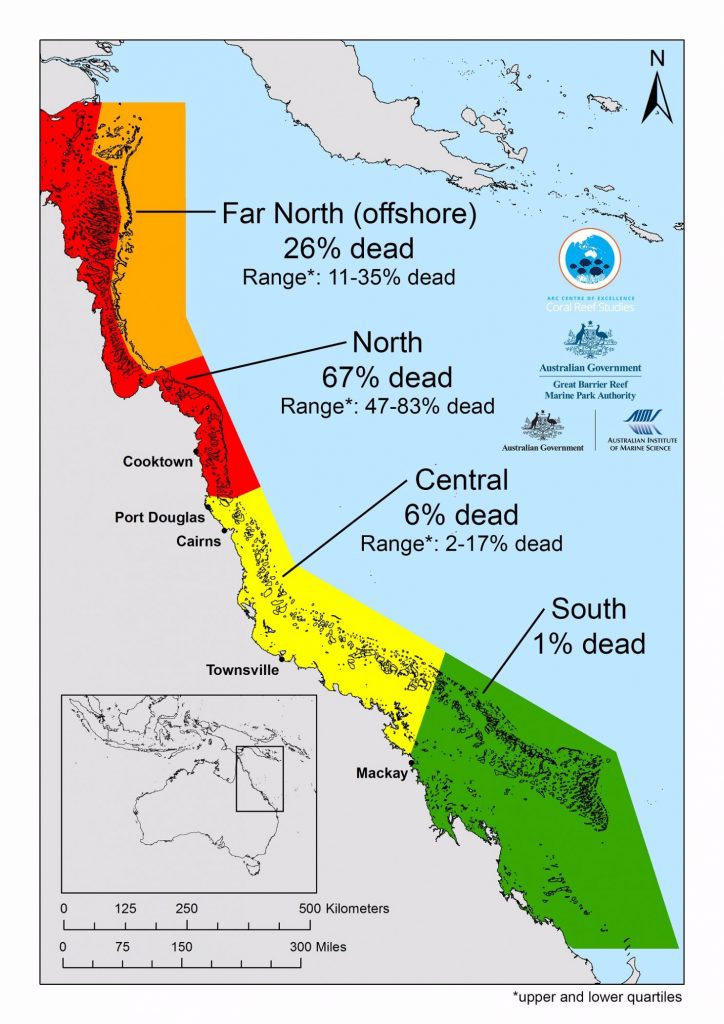
Australian researchers who have been surveying the damage at the Great Barrier Reef from an unprecedented coral bleaching event earlier this year released a new map Monday, showing a large zone of intense coral death as well as several regions that, hearteningly, escaped largely unscathed.
The results confirm an overall picture suggesting that the northern part of the reef, which scientists say was once its most “pristine,” has seen devastating losses. This is a region extending some 700 kilometers (435 miles) northward from Port Douglas, the researchers say, and comprises about 30 percent of the reef overall (it is 2,300 kilometers, or 1,429 miles long, in its entirety). And the researchers say it saw an average coral mortality of 67 percent (the range was actually 47 to 83 percent at disparate reefs that comprise the larger northern section of the Great Barrier Reef).

But the new analysis also contained some good news in that a lengthy offshore part of the northern reef appeared to fare better than its coastal side. Here, average coral death was only 26 percent. This marks a departure from some prior analyses, which had generally depicted an undifferentiated disaster for the northern reef.
“Here we are, eight months later, and we’re still measuring slowly accumulating levels of mortality,” said Terry Hughes, who directs the ARC Centre of Excellence for Coral Reef Studies at James Cook University, which released the map.
“The map tells the story that the barrier reef has been turned into a giant jigsaw puzzle in terms of those four zones,” Hughes said. He added that “there is a bit of a silver lining in terms of the southern half being okay, and there was also a northern region offshore that had significant mortality but not as high as the red region.”
Indeed, coral mortality is at only 6 and 1 percent in the central and southern parts of the reef, respectively. A press release from the ARC Centre hailed this as good news for the reef’s tourism industry, which it said is worth $5 billion per year (in Australian dollars).
The original coral bleaching event occurred when an oceanic “heat wave” featuring temperatures 1 degree Celsius warmer than normal hit the reef in March, which is summer in the southern hemisphere. The warming was tied to the extremely strong global El Nino event of 2015-2016, but scientists also attributed the anomalous heat to climate change.
Coral bleaching occurs when corals, subjected to stresses like these warm temperatures, eject symbiotic algae that they rely upon to survive and then lose their color, turning white. The Great Barrier Reef also bleached in 1998 and 2002, but not as extensively.
The new analysis underscores that far more of the reef saw coral bleaching than actually saw extensive coral death. That’s because where the bleaching was not so severe, the reef has now largely recovered. This is true of its central and southern sections.
However, in the north, not only did severe bleaching trigger considerable coral death, but that has now been compounded by coral disease and predators, Hughes said.
“Because the corals have declined by on average 2/3 but the predators of the corals haven’t changed, the amount of predation per coral, per capita, has gone up very substantially,” he said. “So a lot of the surviving corals in the north were being eaten, at a level, a rate that’s much higher than before the bleaching.”
The good news, Hughes said, is that the forecast is for cooler waters in the southern hemisphere this summer, which should allow for some slow recovery. Full recovery, however, would require 10 or 15 years without another bleaching disaster. And it’s not clear that, in the new climate normal for the reef which appears to date back to 1998, there will be that much of a reprieve.
“The big threat. . .is that we’ll actually see a 4th or even a 5th bleaching event happen in the time frame it takes for those corals to recover,” said Hughes.
(c) 2016, The Washington Post · Chris Mooney
Image: Greg Torda, ARC Centre of Excellence for Coral Reef Studies

